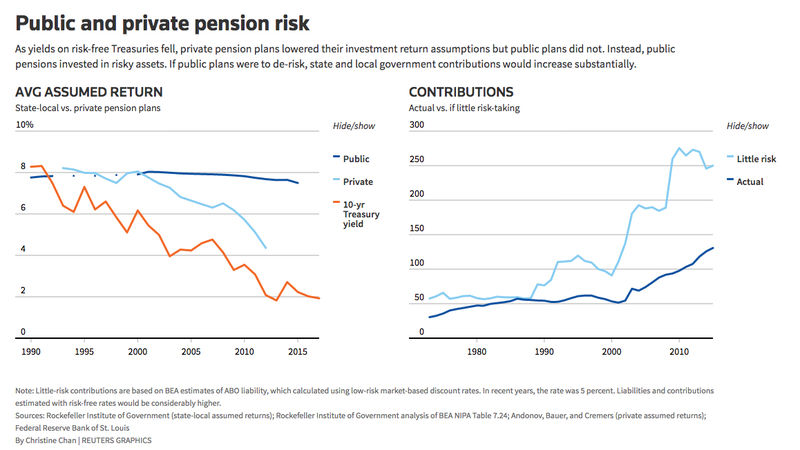By Robin Respaut
SAN FRANCISCO (Reuters) - U.S. public pension funds are cutting their expectations for investment returns over the next 30 years or more, but some do not expect to meet even the new targets over the coming decade.
After a long period of low interest rates, forecasts by investment analysts show the next 10 years will probably bring slower market growth, leading to reduced expectations for the $3.7 trillion of public pension assets.
But public pensions are wary of lowering their expected return rates, or the discount rate, too quickly because doing so would drastically increase costs for state and local governments and their employees, whose contributions form the funds.
Instead, the funds say they plan to make up for lower returns expected in the coming decade over the next 30 years or more.
“Pension funds are in an extraordinarily difficult political situation,” said Don Boyd, fiscal studies director at the Rockefeller Institute of Government.
If they protect their portfolios by moving assets into safer, lower-return investments, he said, “they will have to drastically increase the cost for local governments. They are reluctant to do that.”
The California Public Employees' Retirement System, the largest U.S. public pension fund, anticipates annual returns of 6.2 percent over the next decade.
However, CalPERS still expects its long-term return to align more closely with a discount rate that it plans to reduce to 7 percent by 2020, because it anticipates returns will jump to 7.83 percent in the decades to follow.
Such a forecast in the short term could spell declining fund conditions, a rise in unfunded liabilities and increased costs for government employers and workers.
CalPERS is not alone. The Ohio Public Employees Retirement System expects an average 6.76 percent return over the next five to seven years, short of its 7.5 percent discount rate. But the fund anticipates returns will climb to 7.85 percent over a 30-year period.
Los Angeles Fire and Police Pensions expects compound returns of 6.33 percent over the next decade, considerably below its 7.5 percent discount rate. The fund believes the compound return “will rise over the long-term as interest rates move back up,” said General Manager Ray Ciranna.
PAST IS PROLOGUE
Private-sector and public plans in Canada and Europe lowered their discount rates over the past two decades. But U.S. public pension funds maintained higher return expectations and put more of their money in risky assets to help achieve them, according to the Rockefeller Institute.
As a result, the potential impact of investment shortfalls, relative to government tax revenue, is now more than three times as large as it was in 1995, and about 10 times as large in 1985, the Rockefeller Institute found.
CalPERS hopes to avoid another calamity like the one it experienced during the 2008 recession, when its funding status dropped to 61 percent from 100 percent.
Like the vast majority of U.S. public pensions, the $307 billion fund is now paying out more money to retirees than it is collecting from current workers and employers.
“It’s a challenging market to operate in,” said CalPERS Chief Investment Officer Ted Eliopoulos. “When you’re in that position, you need to be asymmetrically concerned about downside risk as upside risk.”
CalPERS has reduced volatile stocks and private equity from its portfolio. It made more than $9.2 billion in net equity sales in September and October, according to fund documents. In December, the board reduced the discount rate to reflect the new portfolio allocation.
The new expectations still did not reflect investment advisers’ short-term forecasts. Wilshire estimated only a 17 percent probability that CalPERS would earn its new 7 percent discount rate over the next decade.
At the time, CalPERS board member J.J. Jelincic proposed reducing expectations further to align the discount rate more closely with advisers’ forecasts. “6.25 is the reality,” Jelincic said at a December meeting.
But the board worried that the costs of such a move would require even higher contributions from California governments and workers.
Cities are already warning of the impending strain.
Scotts Valley, a small city outside of Santa Cruz, expects its annual pension costs to jump by nearly 75 percent over three years under CalPERS’ new discount rate. By 2021, the city’s annual pension contributions will reach $2.8 million, about 16.3 percent of the city’s total budget, up from $1.5 million, or 9.6 percent, today.
“Even though I personally would like to see a lower assumption,” CalPERS board member Dana Hollinger said in December, "I realize it would be too much of a strain on budgets."
